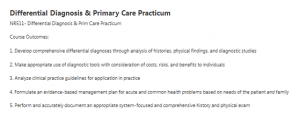Differential Diagnosis & Primary Care Practicum

NR511- Differential Diagnosis & Prim Care Practicum
Course Outcomes:
1. Develop comprehensive differential diagnoses through analysis of histories, physical findings, and diagnostic studies
2. Make appropriate use of diagnostic tools with consideration of costs, risks, and benefits to individuals
3. Analyze clinical practice guidelines for application in practice
4. Formulate an evidence-based management plan for acute and common health problems based on needs of the patient and family
5. Perform and accurately document an appropriate system-focused and comprehensive history and physical exam
6. Demonstrate novice level proficiency in prioritizing patient needs
NR511: #1 SNAPPS Oral Presentation – Gastroesophageal Disease
NR511: #2 Clinical Practice Guidelines Presentation Presentation – Allergic Rhinitis
NR511: #3 Wk 3 Clinical Case Study Differential Diagnosis Discussion – Allergic Rhinitis
Artifact #1: Allergic rhinitis PowerPoint. The purpose of this assignment was to create a problem-based learning methodology designed to help students develop the reasoning process used in clinical practice. In this assignment I created a treatment plan for allergic rhinitis based on the most current clinical practice guidelines. This assignment correlates with program outcome #5 by formulating an evidence-based management plan for acute and common health problems based on the needs of the patient and family.
Artifact #2: History and physical discussion. The purpose of this assignment was to teach the student how to summarize the history and physical findings briefly and concisely as if you were presenting it to another health care team member using the pertinent facts from the patient. This assignment connects with program outcome #5 by developing comprehensive differential diagnosis through analysis of histories, physical findings, and diagnostic studies.
Artifact #3: Week 2 SNAPPS assignment. The purpose of this assignment is to create a learner centered approach to case presentation in the clinical setting. The SNAPPS model allows the student to take an active role in their educational encounter by discussing the patient encounterbeyond the facts. In this assignment I was able to summarize patient findings into an organized oral presentation. This assignment correlated with program outcome #5 by making appropriate use of diagnostic tools (SNAPPS) with consideration to costs, risks, and benefits to individuals.